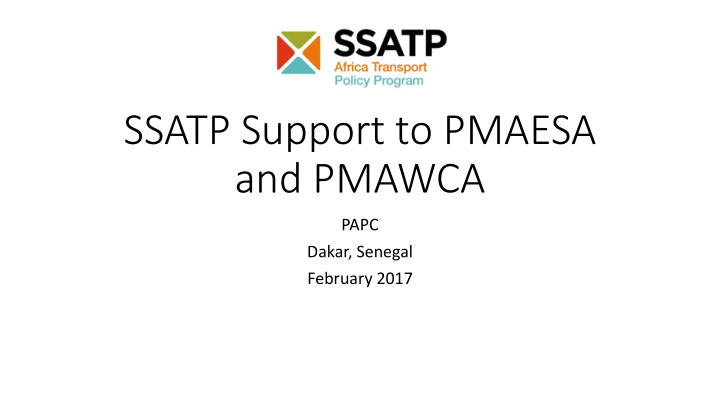



SSATP Support to PMAESA and PMAWCA PAPC Dakar, Senegal February 2017
Container Terminal Concession Guidelines
Why the container terminal concession guidelines? • Background: • The challenges: • The momentum of terminal • Most concessions were made in ‘crisis concession picked up in Sub-Sahara mode’: Africa in the early 2000s • The constraints of inadequate facilities • What was perceived as niche market unable to cope with the pace of containerization of the Africa seaborne has become mainstream: trade was an obstacle to growth • Many more players interested than the • Primary objective was to upgrade of ‘Africa specialists’ the container facilities, not necessarily • More ambitious developments long term vision • Despite slow-down in global trade, • Difficult learning curve: container traffic will continue to • New set of issues and skills required increase, requiring additional from the port authority terminal capacity • Asymmetry: ports and governments • New concessions and renewal of negotiating with very experienced international TOCs existing ones over the next few years
What is in it? • Scope: • As the title says: container terminals, not Background the other types port concessions • Does not replace other resources (Port • The issues, the challenges, the players Reform Toolkit, etc.) • The Guidelines identify critical issues that need specific attention throughout the process, and also highlight areas where The Concession process specialized support may be useful to • International tender or direct negotiations: ensure a successful outcome the dos and don’t • Not ‘one size fits all’ approach, but rather clarify the consequences and rationale for critical choices that need to be made in a Managing the Concession concession • Consequences of the choices in the concession • Examples drawn from Sub-Sahara Africa contract, tips and tools for oversight
What next? • Short term: • Longer term: • Feedback from port management • Identify support needed by port on the guidelines authorities and governments for the future concessions • Sharing stories/learning from past • Promote sharing of performance experience: indicators by terminals • Things that could have been done differently • Develop customer feedback loops • Things that worked well • More examples • Workshops on container terminal concessions for port MDs organized by the port associations
Port Performance Indicators
Why PPIs? • Background: • The challenges: • Pioneering work from UNCTAD • PPIs are mostly seen as ‘nice to have’ and not necessarily part and parcel of • Long standing topic for the two port efficiency drive associations and the ports, but • Relevance is both local and regional, different levels of PPI collection, review and publication across ports short term and long term: • Development of IT (terminal • Local and short term: foundation of efficiency improvement operating systems, VTS, Single • Regional and longer term: optimization Windows) creates new potential data of regional investment and transport sources (but also challenges) networks and services • Transformation of the ports into landlord authorities: managing the integration of operational data from multiple terminals
The PPIs program with PMAWCA / PMAESA • Where we are: • What is yet to be done: • Assessments of what exists and • Complete a second round of data could be expanded were collection to compile four years conducted in 10 pilot ports (Dakar, 2013 to 2016 inclusive Abidjan, Tema, Douala, Pointe • Consideration to include Lagos Noire, Lobito, Maputo, Mombasa, • Economic note on the 10 (or 11 if Dar es Salaam and Djibouti Lagos is included) activity for the • Synthesis report on main findings: four years period gaps and practices • Development of guidelines on ‘how to collect and use port performance statistics’ (guidelines on operational level are lacking)
Requested input from associations & ports? • Short term: • Longer term: • Facilitate the second round of data • Rethink next generation of IT systems for collection (Q2 2017) port operations and data integration • Reflect on set of recommendations: • Partner with training organization to deliver the PPIs training • Internal review IT / Corporate planning / marketing dept. to enhance current set of • Sharing PPIs as global public goods: PPIs • Port community • Integration of data across terminals and • Development partners functions (within existing IT systems) • RECs and regional integration institutions • Improve on dissemination and sharing (port • Corridor Management Institutions community and wider audience through Internet) • Coordination and monitoring mechanisms – port & Associations levels – to ensure collection/production/dissemination • Inspiration for other ports?
Thank you yyedan@worldbank.org ohartmann@worldbank.org
Recommend
More recommend